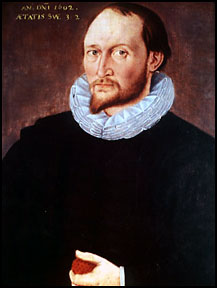|
|
|
|

Thomas Hariot, 1602.
Notes on the Portrait.

THOMAS HARIOT, (or Harriot), an eminent mathematician and astronomer, was born at Oxford in the year 1560. He took his degree of Bachelor of Arts
in 1579, and in 1584 he accompanied Sir Walter Ralegh in his expedition to Virginia, where he was employed in surveying
and mapping the country, and upon his return to England in 1588 he published his ' Report of the New found land of Virginia, the commodities there
found to be raised, &c.'
Hariot was introduced by Sir Walter Ralegh to the earl of Northumberland, whose zeal for the promotion of science had led him to maintain several
learned men od the day, such as Robert Hues, Walter Warner, and Nathaniel Tarporley. This enlightened nobleman received Hariot into his house, and
settled on him an annual salary of 300l., which he enjoyed to the time of his death, in July 1621. His body was interred in St. Christopher's
Church, London, and a monument erected to his memory, which, with the church itself, was destroyed by the
great fire of 1666.
During his lifetime Hariot was known to the world merely as an eminent algebraist; but from a paper by Zach in the 'Astronomical Ephemerish' of the
Royal Academy of Sciences at Berlin for the year 1788, it appears he was equally deserving of eminence as an astronomer. The paper referred to contains
an account of the manuscripts found by Zach at the seat of the earl of Egremont, to whom they had descended from the earl of Northumberland. From it
we learn that Hariot carried on a correspondence with Kepler concerning the rainbow; that he had discovered the solar spots prior to any mention having
been made of them by Galileo, Scheiner, or Phrysius: also that the satellites of Jupiter were observed by him January 16, 1610, although their first
discovery is generally attributed to Galileo, who states that he had observed them on the 7th of that month. A correspondence with Kepler on various
optical and other subjects is printed among the letters of Kepler.
Ten years after Hariot's death his algebra, entitled 'Artis Analyticæ Praxis, ad Æquationes Algebraicas nova, epedita, et Generali Methoda,
resolvendas,' was published by his friend Walter Warner. It is with reference to this particular work that Descartes was accused of plagiarism by Wallis,
whose admiration of its author was so high, that he could not even see the discoveries of Vieta anywhere but in the 'Praxis' of Hariot. This charge
however has sunk with time, though the French writers still continue to answer it. The geometry of Descartes appeared in 1637, six years after the
publication of Hariot's algebra.
Excerpted from:
The Penny Cyclopædia. Vol XII.
London: Charles Knight & Co., 1838. 56.
 | to Thomas Hariot |
Site copyright ©1996-2023 Anniina Jokinen. All Rights Reserved.
Created by Anniina Jokinen on January 13, 2007. Last updated May 14, 2023.
|
|
The Tudors
King Henry VII
Elizabeth of York
King Henry VIII
Queen Catherine of Aragon
Queen Anne Boleyn
Queen Jane Seymour
Queen Anne of Cleves
Queen Catherine Howard
Queen Katherine Parr
King Edward VI
Lady Jane Grey
Queen Mary I
Queen Elizabeth I
Renaissance English Writers
Bishop John Fisher
William Tyndale
Sir Thomas More
John Heywood
Thomas Sackville
John Bale
Nicholas Udall
John Skelton
Sir Thomas Wyatt
Henry Howard
Hugh Latimer
Thomas Cranmer
Roger Ascham
Sir Thomas Hoby
John Foxe
George Gascoigne
John Lyly
Thomas Nashe
Sir Philip Sidney
Edmund Spenser
Richard Hooker
Robert Southwell
Robert Greene
George Peele
Thomas Kyd
Edward de Vere
Christopher Marlowe
Anthony Munday
Sir Walter Ralegh
Thomas Hariot
Thomas Campion
Mary Sidney Herbert
Sir John Davies
Samuel Daniel
Michael Drayton
Fulke Greville
Emilia Lanyer
William Shakespeare
Persons of Interest
Visit Encyclopedia
Historical Events
Field of the Cloth of Gold, 1520
Pilgrimage of Grace, 1536
The Babington Plot, 1586
The Spanish Armada, 1588
Elizabethan Theatre
See section
English Renaissance Drama
Images of London:
London in the time of Henry VII. MS. Roy. 16 F. ii.
London, 1510, the earliest view in print
Map of England from Saxton's Descriptio Angliae, 1579
Location Map of Elizabethan London
Plan of the Bankside, Southwark, in Shakespeare's time
Detail of Norden's Map of the Bankside, 1593
Bull and Bear Baiting Rings from the Agas Map (1569-1590, pub. 1631)
Sketch of the Swan Theatre, c. 1596
Westminster in the Seventeenth Century, by Hollar
Visscher's Panoramic View of London, 1616. COLOR
|
|